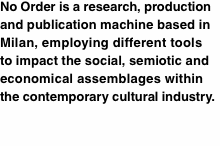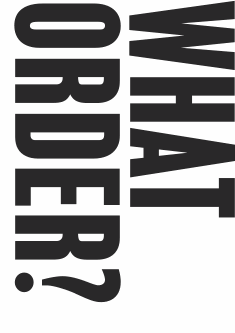
|
|
In January 2010 one of New York’s most renowned art dealers becomes the first gallery owner to assume the
leadership of one of the major contem-porary art museums in the US. After
receiving a 30 million dollar gift from millionaire Eli Broad for its 30th
anniversary, by now vulnerable to
the irreversible financial crisis, the
Los Angeles MOCA sanctions as its directional model a new union of marketing and
art, contradicting the conventional appointment protocols.
In May 2010, British Minister of the Treasury George Osborne announces
unprecedented public spending cuts
to reduce the national deficit. This drastic correction of public funding and
welfare portrays a crisis scenario that has not been seen in over 30 years. On
the other hand, such an austerity measure has by now become the objective, with
varying strategies, toward which all of the policies of European governments
are heading. The G20 Summit held in Toronto
the following June, far from finding
a possible solution to the economic crisis, only reinforced the processes of
financialization. It reconfirmed the US-China axis of mutual assistance and
gave its approval to a European logic of the everyone-for-himself kind,
proclaiming restrictive fiscal policies, once again hitting the labour class,
and continuing with the dismantle-ment of basic social services. At the end of
August Hans Ulrich Obrist sets his own record in his ongoing series
of interview marathons. For the 12th Venice Architecture Biennale the famous
curator organizes ad hoc one of his language-intensive work sessions interviewing nonstop all the
biennial’s participants. The technicians, the experts, and the operators are the forces,
while the interviews are the necessary forms in the production of value. It is about capturing valorising qualities in real
time and in a relation-ship of externality. It is hardly an accident if the
Biennale’s very title is People meet in architecture. In early September the board of the Manifesta Foundation reconvenes to appoint
the subsequent Biennale’s artistic direction, which from the 5-curator team of its original edition now
has a single one. The board decides to carry on the selection process within an
abandoned Belgian coal mining factory from the early 20th century. However, the
location chosen for this ‘closed-door’ selection is in fact the
|
former office of the company’s manager, still furnished in its 1930s austere style. The trading of roles
between the Fordist industry of the past and today’s post-Fordist venture leaves them totally unchanged: one productive centrality
is replaced by another of the same kind, and whereas workforce was once
imported, the company’s aim now becomes to import a flow of paying public. The scenario of the forms
of subjugation has not changed either, even though today’s slogan is to adopt ‘open-ended, democratic procedures.’ Remember the great film in which four representatives of the Powers
of the State, alongside three female narrators, decide to shut themselves up
within an isolated villa for 120 days with the goal of selecting young people
through a set of rules of their own making? And then, in September, the 29th São Paolo Biennale’s allegedly political claim is swiftly proven wrong. The curators’ claim that ‘it is impossible to separate art from politics’ starkly contrasts with the immediately accepted censorship of a work in which
the image of the Brazilian Labour Party’s candidate for the incoming presidential elections faces that of her Social
Democrat rival. On November 22nd the Berlin Biennale’s new curator launches an
open call for self-described political artists of any allegiance and kind. Whatever
commitment could have been evinced from the decision to intervene in the
selection procedures is promptly countered by the selection criteria
themselves, founded on the curator’s conventional ‘intuition and ambiguity,’ and as such unable to provide the call’s applicants with any sort of guarantee of being invited. Once again, what is at
stake here is an instance of productive outsourcing and unpaid labour
extraction, as well as a marketing strategy. On December 4th a special
e-flux announcement informs all art users that the 8th Gwangju Biennale broke its
attendance records with 491,697 paying visitors over its 66 running days, a 25%
increase from the previous edition. Compared to Manifesta’s 109,678 visitors and the Venice Architecture Biennale’s 179,801, the Gwangju Biennale attests to be one of the most visited
exhibitions in the world. What do all of these events have in common? It is
easy to understand how all of these
|
symptoms share a single matrix: that which we call post-Fordist capitalism, in
which financialization is just the other face – ‘adapted and perverse’ – of the contemporary transformation of labour and its value. Such labour now
coincides with productive strategies in which the workforce’s knowledge and cognitive competencies, and ultimately everyone’s very life, assume the role formerly played by machines in the Fordist era.
Here, in the socially diffused factories of cognitive capita-lism, exploitation
is less and less visible: it reaches so far beyond the boundaries of
contractual working hours that it economically colonizes life itself,
subjugating and controlling the space of ‘free’ productive action. It’s not enough to have the courage to publicly denounce, as the great Peter
Watkins did in 2003, the production company of one’s latest film, exposing its economic implications and forms
of corruption as soon as they are discovered. It is no longer a moral issue.This
is about becoming aware
of new time-space geographies of global knowledge production, as well as of the
figures of today’s emerging workers, by starting this reflection from the radical acknowledgment
that these figures are still politically unarmed and yet incapable of social
recomposition. The invention of new forms of action and coalition seems
to be crucial, especially now when
the crisis is being followed by a reaffirmation of ever more oppressive
neo-regimes and behaviours. Finally, this awareness needs to avoid the cynicism
of the post-Fordist enterprise’s innovative vision as
well as the wage-earner’s nostalgic cynicism and the classical trinitarian formula of
wage-profit-revenue.
If the only option left for art is to
work on work itself, on its own working conditions, it is just as necessary to
consider the cultural industry as a new ground for political struggle. So: why
not attempt to
start anew right here in Milan?
Right from that space in which a
huge process of social transformation has been interrupted?
—Marco Scotini
|


